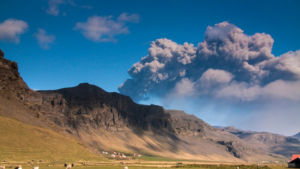Our Explosion related Courses
Explosions are caused by a range of complex reactions which result in the rapid expansion of gas and energy, forming an explosion. When certain gases are exposed to heat or increased pressure, reactions will take place to stimulate the explosion. There are different types of explosions which occur, such as natural, chemical, mechanical and nuclear explosions. Therefore, the causes of these different types of explosion all differ, and it is useful to understand what causes each type of explosion.
Natural Explosions
Natural explosions can be fairly common and occur after there is a large influx of energy. Volcanoes are a natural part of our landscape which experience explosions. Volcanoes erupt and create an explosion when magma rises up to the surface. This magma contains bubbles of gas, and when the pressure builds up, an explosive eruption occurs. The explosion can be destructive for those nearby and the surrounding atmosphere.
In March 2010, the Eyjafjallajokull volcano in Iceland exploded, marking its first eruption since 1821. Consequently, 700 people were evacuated from the area and stayed in Red Cross shelters for temporary safety. This explosion had huge effects upon the environment as ash from the explosion deposited dissolved iron into the North Atlantic, and the ash cloud also affected aeroplane traffic.
Chemical Explosions
Chemical explosions are caused by either decomposition or combination reactions that produce large amounts of extremely hot gas, which expands rapidly and increases pressure. The large amount of hot gas essentially forms shock waves, creating an explosion which can have shattering effects.
For example, gunpowder is one of the first chemical explosives which was used. Dynamite is also an example of a chemical explosive. When dynamite is ignited, it will burn rapidly and release incredibly hot gas and an explosion.

Mechanical Explosions
Mechanical explosions are caused when a high-pressure gas encounters a physical reaction, which consequently ruptures the container in which the gas is contained. Mechanical explosions involve the internal pressure of a contained gas becoming too high and expanding beyond the container’s strength, resulting in the container bursting and the contained gas escaping, creating an explosion.
Nuclear Explosions
Nuclear explosions are caused by either fusion or fission reactions. Fusion and fission reactions can be used in bombs; the splitting of the nuclei of the fissile elements creates a bomb’s core.
Fusion Reactions: These reactions require high temperatures and are initiated by fission reactions.
Fission Reactions: The fission reaction is a process which involves an atom’s nucleus splitting into smaller particles, releasing neutrons and lots of energy.
Common causes of explosions in the workplace
- Electrical Hazards: If static electricity builds up over time, a spark will be ignited, and if a combustible element is included, the explosion can be huge.
- Hazardous Chemicals: Certain workplaces handle hazardous chemicals, and a tiny small spark can ignite a fire or explosion.
- Combustion Engines: Certain workplace environments have combustion engines within them, but if something goes wrong, an explosion can occur.
- Flammable liquids and gas: Workplaces which use flammable liquids and gas are at a greater risk of fires and explosions occurring due to the hazardous nature of the work which is taking place.
Explosions can be caused by a range of reactions, creating dangerous shock waves which can have a range of serious consequences. Therefore, understanding why explosions occur can be useful.


